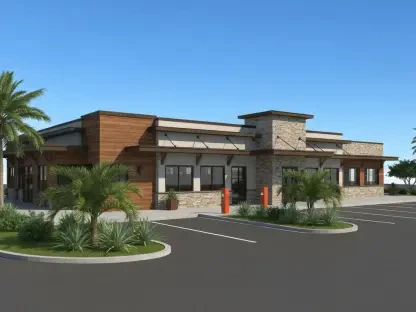As December ushers in the festive season, many in the UK’s hospitality sector have experienced a much-needed uptick in sales, with the boost coming as a welcome reprieve for an industry beleaguered by inflation and strained trading throughout the year. The pre-Christmas period has become a pivotal time for bars, restaurants, and pubs, providing an opportunity to offset financial difficulties from earlier months. Sales data have shown promising signs, hinting at a growing trend for consumer spending over the Christmas holidays despite the broader economic challenges.
Marked Increase in Sales Across Various Segments
Bars Experience Significant Growth
Bars have benefited significantly from the pre-Christmas trading period, reporting a substantial 20.5% increase in sales. This notable growth can be attributed to several factors, including Christmas parties, late-night sports events, and the timing of convenient bank holidays. These occasions have spurred consumers to spend more on celebrating, highlighting a pent-up demand for social activities despite a generally restrained mentality toward spending. This sharp increase in sales in December is a positive indicator for the bar sector, which had faced significant decline throughout the year due to inflationary pressures and changing consumer habits.
The success of the bars illustrates that, while economic difficulties have altered spending behaviors, there remains a strong desire among consumers to enjoy special occasions. This trend offers a positive outlook for the bars as they navigate the challenges ahead. Early 2025 will likely remain uncertain, especially since the beginning of the year typically poses difficulties for late-night venues. However, the performance in December provides a solid base from which operators can strategize for the upcoming months, emphasizing the importance of capitalizing on periods of high consumer demand.
Growth in Food-Led Venues and Pubs
Other hospitality segments also saw increases in sales, albeit more modest compared to bars. Food-led venues such as restaurants experienced a 2.1% growth, while the On The Go sector saw a 3.4% uptick. Pubs, on the other hand, reported only minor growth at 0.7%. Despite these figures being lower compared to bars, they still indicate resilience in the face of economic challenges. The modest growth in these segments underscores the variability in performance across different parts of the hospitality sector.
Restaurants and food-led venues focusing on quality dining experiences have often found their growth hampered by inflated costs of food and labor. Yet, there is an underlying current of steady customer interest aided by festive season indulgences. Pubs, witnessing just marginal improvements, face the ongoing challenge of balancing the traditional appeal of a pub visit with modern consumer preferences inclining towards variety and innovation. The slight increase in sales indicates an enduring patronage but also highlights the need for adaptive measures to stay relevant in a competitive market landscape.
Insights from Data Collection
CGA by NIQ Hospitality Business Tracker
The insights from the pre-Christmas trading period are backed by data collected by CGA by NIQ as part of their Hospitality Business Tracker. This robust tool measures sales performance across restaurant, pub, and bar sectors in an effort to provide businesses with a means to benchmark their performance and stay abreast of market trends. The data is collected monthly from 115 leading managed groups, offering valuable perspectives into the hospitality industry’s sales dynamics and enabling operators to gauge their position relative to the broader market.
Notable participants in the CGA RSM Hospitality Business Tracker include prominent names such as Amber Taverns, Big Table Group, BrewDog, Fuller Smith & Turner, Greene King, Mitchells & Butlers, Pizza Express, Stonegate Pub Co, Wagamama, and Whitbread among others. These companies represent a significant cross-section of the UK’s hospitality sector, ensuring that the data collected offers a comprehensive overview of the industry. With such diverse participation, the insights derived from the tracker are crucial for understanding how different segments are performing and, more importantly, for identifying areas of opportunity and concern.
Benchmarking Performance and Understanding Trends
For operators in the hospitality sector, being able to benchmark performance is vital for strategic planning and decision-making. The CGA RSM Hospitality Business Tracker provides an invaluable resource in this regard, allowing businesses to compare their sales against industry standards and track their progress over time. By analyzing trends and performance metrics, operators can make informed decisions about where to allocate resources, which promotional activities to pursue, and how to adapt to changing consumer behaviors.
Understanding market trends is also crucial for anticipating future challenges and opportunities. As the data indicates uneven growth across different hospitality segments, it becomes clear that one-size-fits-all strategies are insufficient. Each segment may require tailored approaches to address specific challenges, such as rising staffing costs or shifts in consumer preferences. The insights gained from the pre-Christmas trading period highlight the importance of staying vigilant and adaptable in a dynamic market environment.
Challenges and Future Outlook
Variable Performance Across Segments
While the pre-Christmas period brought a much-needed boost to the hospitality sector, the variability in performance across different segments remains a critical issue. Bars enjoyed significant growth, while restaurants and pubs saw more restrained increases. This disparity underscores the need for sector-specific strategies and highlights the importance of understanding the unique challenges faced by each segment. The sustained growth for bars points to a strong consumer demand for social activities and special occasions, whereas the modest growth in food-led venues and pubs indicates that these segments may need to refine their offerings to attract more patrons.
Looking ahead, the outlook for early 2025 remains uncertain, particularly for late-night venues which historically face a challenging period at the start of the year. Operators will need to stay agile, leveraging data and insights to make informed decisions. The continued monitoring of market trends and performance through tools like the CGA RSM Hospitality Business Tracker will be essential for navigating the post-holiday slump and preparing for future opportunities.
Rising Staffing Costs and Strategic Considerations
As December heralds the festive season, many in the UK’s hospitality industry are experiencing a much-needed surge in sales. This increase has been a welcome relief for an industry that has faced significant challenges throughout the year, such as inflation and strained trading conditions. The period leading up to Christmas has become crucial for bars, restaurants, and pubs as it presents an opportunity to counterbalance the financial hardships encountered earlier in the year. Recent sales data indicate positive trends, suggesting an upward trajectory in consumer spending during the Christmas holidays despite the broader economic difficulties. This seasonal boost is particularly important for an industry that has endured numerous setbacks, providing a glimmer of hope and a chance to recover some of the losses sustained over previous months. The festive period not only brings joy to patrons but also offers a lifeline to businesses navigating a tough economic landscape. Given these circumstances, it’s clear that the pre-Christmas rush plays a critical role in the survival and success of many hospitality venues.









